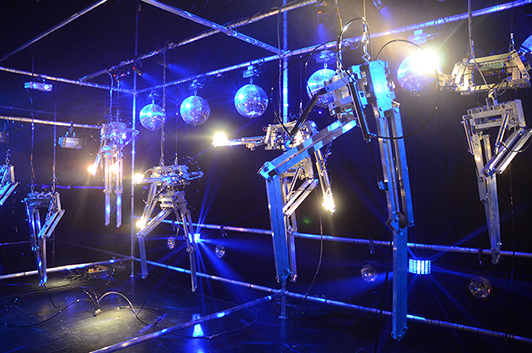Copacabana Machine Sex is a 30-minute burlesque musical robotic performance involving solely biomorphic machines as actors, musicians and dancers. My goal is not to replicate a real cabaret, but to conceive a metaphorical extravaganza in response to the question: “What would happen if machines would be on a cabaret stage?” Aesthetically speaking, the set is a strange hybrid mix between the classic Broadway kitsch and the dark industrial look of my previous works. Like most of my work, it is an exploration of robotic forms and movements through music, sound and light.
The Copacabana performance can be described as a mini Music Hall show, hence its title, as so many nightclubs around the world are called this way. It involves a succession of different musical numbers where machines perform on stage as actors, musicians and dancers. The performance is created in a way that it can either be configured for a traditional Italian stage or with viewers standing all around a central ground-level presentation. Copacabana is comprised of twelve robotic entities: one main central character full of halogen bulbs, four carnaval dancers with LED fans, six pairs of robotic legs, and one suspended set of six roboticized human skulls. The soundtrack is a mix of disco, rap, latino, techno, industrial and ambient music, and all the robot movements and lighting effects are perfectly synchronized to the beat.
The “machine sex” theme is not approached on the literal or strict sense, but in a more subtle manner where machines are obviously not presented as having intercourse with each other but rather involved in a seduction endeavor between themselves and with the viewers. Even though we can refer to this perfor-mance as being a “machine burlesque” spectacle, my aim is not to create a deviant or satirical sex show, but to evoke human behaviors in an unusual manner through simplistic machine actions presented in a familiar Music Hall / cabaret context.

